Steve Karroll SES Review
This is the rarest of knife reviews--a long term review of a USER handmade knife. In many ways, the gear hobby is about buying and selling gear more than actually using it. Nothing is more emblematic of that trend than how most people treat handmade (custom) knives (see here for why I prefer the term handmade over custom; this is a handmade single source knife, BTW). They are like Pokemon--the fever is in the acquisition of them, not the using and carrying of them. And the idea that someone would--gasp--hold on to one for two years AND use it the entire time, well, that's like a supermodel that eats food or a politician with integrity--a true rarity. The funny thing is there have a been a few times when I thought I might have to sell the SES, but fortune shined on me and I was able to keep it. I am very glad I did because this is a knife that, for me, epitomizes why people should even bother with handmade knives--it is a unique, high performance, and distinctly pleasing tool to own, use, and handle. There are no production knives that have the feel of the SES and for that reason, it makes it worth the hassle, money, and effort to track one down.
When I reviewed the EDMW a few years ago Steve had been making knives for a while but wasn't a big name. He still isn't the biggest name in the knife world, but folks know who he is and his knives are collected and sought after. There is a distinctive feel to a Karroll knife--beefy and tough but not Klingon or Bunyanesque (some would say Rubenesque). Its a knife that can do real work and is still available at a reasonable price (don't ask me what that is now, contact Steve, here is his Facebook page). Awesome thing about Steve is that he still regularly sells knives on his page for table cost. Its rare, but it does happen.
No product page, this is a one of a kind (though Steve does make other SES's). My SES cost either $450 or $475 (I bought it in person at a Northeast Cutlery Collectors Association show, here is a plug to join your local knife club...the annual membership fee is easily offset by the ability to rub elbows and chat knives and occasionally land an awesome blade with zero wait at table prices), I can't remember. No reviews or videos other than the one I posted earlier in the week. Here is the write up I did for Gear Junkie (with more pics, this is one photogenic blade).
Here is my SES (purchased with my own money and mine to keep):

and here is the knife two years later:
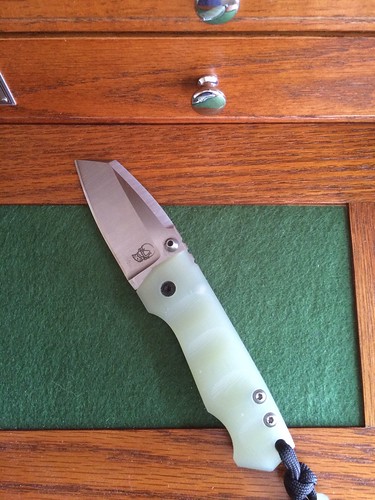
Twitter: All of the reasons you should buy a custom in one place.
Design: 2
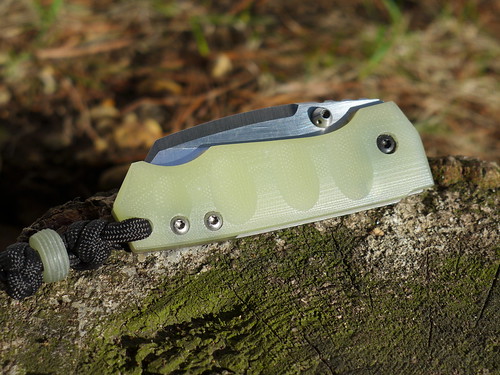
How do I know it is an essential part of the design? Well, I bought the knife without the lanyard because it had yet to receive one. Steve offered to send me the knife the next week, but I was transfixed by a new shiny and opted to go without. When I sent the knife back to Steve (more on that below), it came back with the lanyard and it was a much better knife for it.
The performance ratios are weird, as is this whole knife. Because this is a unique knife here are the specs: The blade is 2.75 inches exactly and the cutting edge is 2.5 inches, again, exactly. The knife is a bit of a chubby thing, weighing 3.78 ounces (notably still below the arbitrary but good Nutnfancy rule of 4 ounces). Closed length is 3.5 inches. With clip, the knife is .75 inches thick. The blade at its tallest is 1.125 inches tall. The blade:weight is .73. The blade:handle is .79.
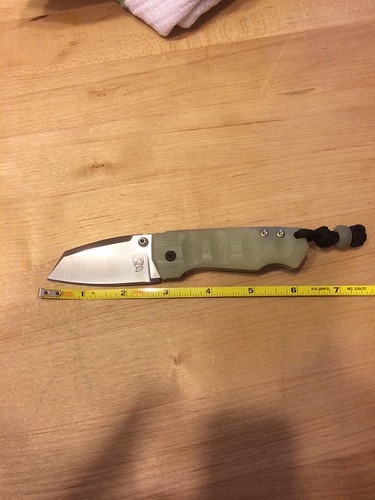
Fit and Finish: 1
Grip: 2
Blade Shape: 2
Grind: 2
Deployment Method: 2
Retention Method: 2
Lock: 2
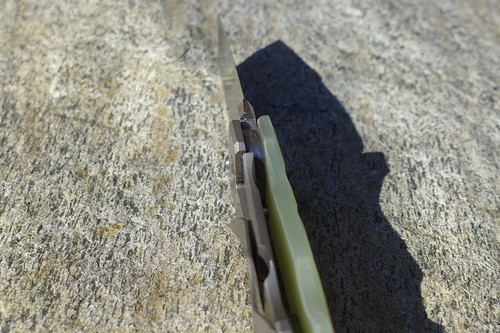
I mention this because this is not a sure thing. I have had customs that did not do this, but the SES has been perfect. Also, the lock is easy to engage, easy to disengage and there is no blade play or lock rock at all. Exactly what you want and it has a tight, bank vault feel that makes you think that handmade knives are, in fact, special.
Overall Score: 19 out of 20
Other than the fit and finish issue with the screw and a very small wobble in the grind towards the ricasso, this is a flawless knife, and interesting tool, and a very high value custom. You aren't gioing to find a production knife that has the same look, feel, or performance. Steve is a very creative guy and he knows knives and the SES is an outgrowth of that. It is a superb everyday carry and despite a few money crunches over the years that almost required me to sell it, I am very glad I didn't. Its part of the permanent collection now, the only handmade knife in my untouchables. This, friends, is the joy of handmade knives--unique, fun to use, and a great discovery. Go see if you can find a Karroll. They come up for sale every now and then and they go fast, but man, are they sweet. And you know Steve has great taste--I saw him tying lanyards with a Reese Bose Texas Toothpick at a knife show once. This is the work of a craftsman that has deep knowledge of his craft and boundless creativity.
The Competition
There is not a lot out there like the SES other than stuff from Steve. The Techno is similar (and for good reason, Marcin Slysz is one of Steve's main influences), but the SES is even beefier and significantly better in hand. It is also a better slicer thanks to on heck of a grind. The upcoming Sinkevich ZT0456 is similar, though bigger. In the end, the lack of comparables is one of the reasons I like the knife so much--there is little out there like it.
When I reviewed the EDMW a few years ago Steve had been making knives for a while but wasn't a big name. He still isn't the biggest name in the knife world, but folks know who he is and his knives are collected and sought after. There is a distinctive feel to a Karroll knife--beefy and tough but not Klingon or Bunyanesque (some would say Rubenesque). Its a knife that can do real work and is still available at a reasonable price (don't ask me what that is now, contact Steve, here is his Facebook page). Awesome thing about Steve is that he still regularly sells knives on his page for table cost. Its rare, but it does happen.
No product page, this is a one of a kind (though Steve does make other SES's). My SES cost either $450 or $475 (I bought it in person at a Northeast Cutlery Collectors Association show, here is a plug to join your local knife club...the annual membership fee is easily offset by the ability to rub elbows and chat knives and occasionally land an awesome blade with zero wait at table prices), I can't remember. No reviews or videos other than the one I posted earlier in the week. Here is the write up I did for Gear Junkie (with more pics, this is one photogenic blade).
Here is my SES (purchased with my own money and mine to keep):

and here is the knife two years later:

Twitter: All of the reasons you should buy a custom in one place.
Design: 2
My favorite thing about the SES and Steve's knives in general is that they are built with everyday carry in mind. The knife is a short knife. For me, the handle is a three finger grip, but Steve designs these smaller knives with the intention of having a lanyard give you an extra finger of grip. The large lanyard bead and the tight knots make it perfect in that roll of extra grip. It also makes the knife easier to retrieve in the pocket. I know lots of folks include a lanyard, but to have the knife built around this idea is interesting to me. For many knives it's just a place to store some extra bling. For Steve, it's an essential part of the design.

How do I know it is an essential part of the design? Well, I bought the knife without the lanyard because it had yet to receive one. Steve offered to send me the knife the next week, but I was transfixed by a new shiny and opted to go without. When I sent the knife back to Steve (more on that below), it came back with the lanyard and it was a much better knife for it.
The rest of the knife is just as nice--the show side G10 is contoured with divots to accommodate better grip. The blade is massively thick with good jimping and the thumb stud is just right--enough to hit with a thumb, but not so much that it snags on stuff. In short, the design is unlike anything else (other than another Karroll) and yet it works exceedingly well.
The performance ratios are weird, as is this whole knife. Because this is a unique knife here are the specs: The blade is 2.75 inches exactly and the cutting edge is 2.5 inches, again, exactly. The knife is a bit of a chubby thing, weighing 3.78 ounces (notably still below the arbitrary but good Nutnfancy rule of 4 ounces). Closed length is 3.5 inches. With clip, the knife is .75 inches thick. The blade at its tallest is 1.125 inches tall. The blade:weight is .73. The blade:handle is .79.

Fit and Finish: 1
When I got the SES the knife was tight. Very tight. As many customs are when they ship. But over time it loosened up. During this process I noticed that the blade started to walk away from the lock when closed, to the point that it rubbed the liner. I loctited the pivot to no avail (and with Steve's approval). So eventually I sent it back to Steve and he fixed it. Two years later, the blade has yet to walk on me, so I think the problem is cured. Steve dropped in the black pivot screw because that is what he had at the time and he tied on the lanyard. Overall, the knife came back better than it was when I sent it, but the pivot thing is only one part of the point deduction. The grind near the ricasso is a bit sloppy and Steve's logo isn't the cleanest etch I have ever seen. It makes the blade look perpetually dirty. None of the issues that exist now impact performance and this is my user handmade knife so I am not too concerned with the mismatched pivot screw (though I think a complete black out version would look sweet), the wobbly grind at the end, and the messy logo. That said, this knife was almost $500 so all of that together results in the loss of a point.
Be aware that I have seen Steve's later work and it is much better in all three areas. The logo is cleaner, the ricassos are nicer, and this is the only Karroll I have seen with that particular pivot problem.
Grip: 2
It's really kind of shocking how necessary the lanyard is. When it is on, this is a fantastic knife in the hand.
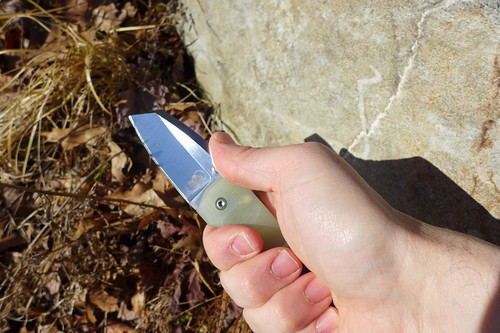
Without it is decent, but not great. The overall shape is very pleasing to the hand and the contouring is quite good, too. Steve knows what he is doing.
Carry: 2

Without it is decent, but not great. The overall shape is very pleasing to the hand and the contouring is quite good, too. Steve knows what he is doing.
Carry: 2
Man, I love carrying this knife. It's just the right size to drop into a good size coin pocket and even in those confined quarters its not so wide or thick that it feels like you are wearing a splint. This is a good knife in your pocket.
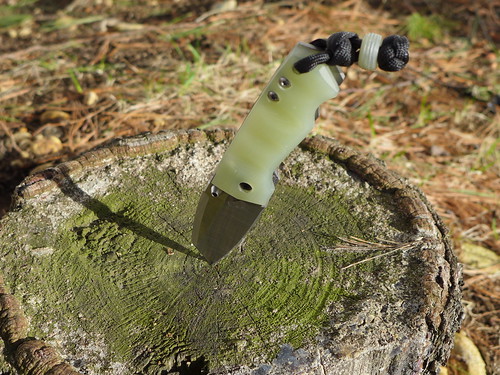

The lanyard makes retrieval a breeze and this is the first lanyard that I have really ever liked (I like my Edge Observer lanyard bead, but I have yet to find a lanyard set up that does it justice). As a clip carry, the knife is quite friendly with other gear, in part because of its short size.
Steel: 2
When I got it two years ago S35VN was a BIG DEAL. It's still a damn good steel and here, with a wicked grind, it has performed very well. I do think there is a real improvement in S35VN over S30V. I have found it easier to maintain an edge and it's less chippy. Given how long I have been using this knife I feel like it's enough to warrant an increase in cost. To me, the jump between VG-10 and S30V was big only in the edge retention department, but here S35VN is just so much better. This is one of those differences that matters to folks that aren't steel snobs.
Blade Shape: 2
Well, the reverse tanto blade shape, so long as it includes a real belly, is one of my three favorite blade shapes (drop point and Spyderco's leaf shaped blade are the other two). Steve's version here is by far my favorite, even if you include another knife I love, the Benchmade 940-1. The continuous curve of the belly is quite useful for a whole range of cutting tasks and the thick tip allows for great penetrating cuts, like the first cut into a giant cardboard box. It's not simple and usually that is my preference, but time and again, the reverse tanto shape has just worked and I have found no better iteration of that blade shape than the one on the SES. This and the grind are the primary reason using this knife is so entrancing. It just does everything well.
Grind: 2
There is something magical about a really deep hollow grind, something that lets you do more work than you should. Here, the thickness of the blade stock requires a good grind and Steve happens to be pretty damn good at putting belt to steel. There is a small wobble on the cutting bevel near the ricasso, but the primary grind, with its many facets, is superb, and the edge, despite the one mistake, is sticky sharp. Two years on, it still pops hair, though I do strop the knife pretty regularly (usually once a month I go through all my blades and strop them).
Deployment Method: 2
Steve has always done thumb studs well and these are great. Once you get the hang of them, you can easily deploy the knife with a coin flip, no wrist action necessary. These are substantially better than the thumb studs on the EDMW I had and they are among my favorite I have seen. I can't remember if they are off the shelf or custom, but either way, they are very good.
Retention Method: 2
Dear Knifemakers,
I know it is trendy to make sculpted clips or funky clips (see Munroe Sigil), but for those of us that use our knives (which I will concede is a very small percentage of your customers), a traditional stamped clip is perfect. It holds the knife in place, it lets you access it easily, and it is very secure. No, it can't be made of mokuti and no, Jim Skelton won't rave about it, but it makes your knife more useful. Oh wait, that doesn't matter? The vast majority of handmade knives are never used? Oh, okay, never mind then. Keep making those terrible Baroque crappy clips.
Sincerely,
The Curmudgeon aka Everyday Commentary
This is a damn good clip. It works, holds the knife in place, and isn't a paint scraper.
Lock: 2
You can have all of the overtravel stops and harden steel pieces you want, but a well made titanium frame lock will work and work for a long time. In two years of real use I have not seen the lock budge at all. I am not using calipers to measure this stuff, but just eye balling it, it looks exact the same as it does in this shot, which was taken about a month after I bought the knife.

I mention this because this is not a sure thing. I have had customs that did not do this, but the SES has been perfect. Also, the lock is easy to engage, easy to disengage and there is no blade play or lock rock at all. Exactly what you want and it has a tight, bank vault feel that makes you think that handmade knives are, in fact, special.
Overall Score: 19 out of 20
Other than the fit and finish issue with the screw and a very small wobble in the grind towards the ricasso, this is a flawless knife, and interesting tool, and a very high value custom. You aren't gioing to find a production knife that has the same look, feel, or performance. Steve is a very creative guy and he knows knives and the SES is an outgrowth of that. It is a superb everyday carry and despite a few money crunches over the years that almost required me to sell it, I am very glad I didn't. Its part of the permanent collection now, the only handmade knife in my untouchables. This, friends, is the joy of handmade knives--unique, fun to use, and a great discovery. Go see if you can find a Karroll. They come up for sale every now and then and they go fast, but man, are they sweet. And you know Steve has great taste--I saw him tying lanyards with a Reese Bose Texas Toothpick at a knife show once. This is the work of a craftsman that has deep knowledge of his craft and boundless creativity.
The Competition
There is not a lot out there like the SES other than stuff from Steve. The Techno is similar (and for good reason, Marcin Slysz is one of Steve's main influences), but the SES is even beefier and significantly better in hand. It is also a better slicer thanks to on heck of a grind. The upcoming Sinkevich ZT0456 is similar, though bigger. In the end, the lack of comparables is one of the reasons I like the knife so much--there is little out there like it.
